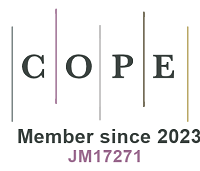REFERENCES
1. Aragaw TA. Surgical face masks as a potential source for microplastic pollution in the COVID-19 scenario. Mar Pollut Bull 2020;159:111517.
2. Filho WL, Salvia AL, Minhas A, Paço A, Dias-Ferreira C. The COVID-19 pandemic and single-use plastic waste in households: a preliminary study. Sci Total Environ 2021;793:148571.
3. Kahlert S, Bening CR. Plastics recycling after the global pandemic: resurgence or regression? Resour Conserv Recycl 2020;160:104948.
4. Xanthos D, Walker TR. International policies to reduce plastic marine pollution from single-use plastics (plastic bags and microbeads): a review. Mar Pollut Bull 2017;118:17-26.
5. Benson NU, Bassey DE, Palanisami T. COVID pollution: impact of COVID-19 pandemic on global plastic waste footprint. Heliyon 2021;7:e06343.
6. Idowu GA, Olalemi AO, Aiyesanmi AF. Environmental impacts of covid-19 pandemic: release of microplastics, organic contaminants and trace metals from face masks under ambient environmental conditions. Environ Res 2023;217:114956.
7. Patrício Silva AL, Prata JC, Mouneyrac C, Barcelò D, Duarte AC, Rocha-Santos T. Risks of Covid-19 face masks to wildlife: present and future research needs. Sci Total Environ 2021;792:148505.
8. Ammendolia J, Walker TR. Citizen science: a way forward in tackling the plastic pollution crisis during and beyond the COVID-19 pandemic. Sci Total Environ 2022;805:149957.
9. Ardusso M, Forero-López AD, Buzzi NS, Spetter CV, Fernández-Severini MD. COVID-19 pandemic repercussions on plastic and antiviral polymeric textile causing pollution on beaches and coasts of South America. Sci Total Environ 2021;763:144365.
10. Prata JC, Silva ALP, Walker TR, Duarte AC, Rocha-Santos T. COVID-19 pandemic repercussions on the use and management of plastics. Environ Sci Technol 2020;54:7760-5.
11. Okuku E, Kiteresi L, Owato G, et al. The impacts of COVID-19 pandemic on marine litter pollution along the Kenyan Coast: a synthesis after 100 days following the first reported case in Kenya. Mar Pollut Bull 2021;162:111840.
12. Hasan NA, Heal RD, Bashar A, Haque MM. Face masks: protecting the wearer but neglecting the aquatic environment? - A perspective from Bangladesh. Environ Chall 2021;4:100126.
13. Li B, Huang Y, Guo D, et al. Environmental risks of disposable face masks during the pandemic of COVID-19: challenges and management. Sci Total Environ 2022;825:153880.
14. Bondaroff TP, Cooke S. Masks on the beach: the impact of COVID-19 on marine plastic pollution. OceansAsia 2020;34:1-79. Available from: https://oceansasia.org/wp-content/uploads/2020/12/Marine-Plastic-Pollution-FINAL.pdf. [Last accessed on 13 Dec 2023]
15. Hiemstra AF, Rambonnet L, Gravendeel B, Schilthuizen M. The effects of COVID-19 litter on animal life. Anim Biol 2021;71:215-31.
16. Ma J, Chen F, Xu H, et al. Face masks as a source of nanoplastics and microplastics in the environment: quantification, characterization, and potential for bioaccumulation. Environ Pollut 2021;288:117748.
17. Rathinamoorthy R, Raja Balasaraswathi S. Mitigation of microfibers release from disposable masks - An analysis of structural properties. Environ Res 2022;214:114106.
18. Huang W, Song B, Liang J, et al. Microplastics and associated contaminants in the aquatic environment: a review on their ecotoxicological effects, trophic transfer, and potential impacts to human health. J Hazard Mater 2021;405:124187.
19. Wang Z, An C, Chen X, Lee K, Zhang B, Feng Q. Disposable masks release microplastics to the aqueous environment with exacerbation by natural weathering. J Hazard Mater 2021;417:126036.
20. Rebelein A, Int-Veen I, Kammann U, Scharsack JP. Microplastic fibers - Underestimated threat to aquatic organisms? Sci Total Environ 2021;777:146045.
21. Saliu F, Veronelli M, Raguso C, Barana D, Galli P, Lasagni M. The release process of microfibers: from surgical face masks into the marine environment. Environ Adv 2021;4:100042.
23. Perez-Venegas DJ, Seguel M, Pavés H, et al. First detection of plastic microfibers in a wild population of South American fur seals
24. Le Guen C, Suaria G, Sherley RB, et al. Microplastic study reveals the presence of natural and synthetic fibres in the diet of King Penguins (Aptenodytes patagonicus) foraging from South Georgia. Environ Int 2020;134:105303.
25. Catalano B, Moltedo G, Martuccio G, et al. Can Hediste diversicolor (Nereidae, Polychaete) be considered a good candidate in evaluating PAH contamination? A multimarker approach. Chemosphere 2012;86:875-82.
26. Paul-Pont I, Lacroix C, González Fernández C, et al. Exposure of marine mussels Mytilus spp. to polystyrene microplastics: toxicity and influence on fluoranthene bioaccumulation. Environ Pollut 2016;216:724-37.
27. Sussarellu R, Suquet M, Thomas Y, et al. Oyster reproduction is affected by exposure to polystyrene microplastics. Proc Natl Acad Sci U S A 2016;113:2430-5.
28. Gonçalves JM, Bebianno MJ. Nanoplastics impact on marine biota: a review. Environ Pollut 2021;273:116426.
29. Au SY, Bruce TF, Bridges WC, Klaine SJ. Responses of Hyalella azteca to acute and chronic microplastic exposures. Environ Toxicol Chem 2015;34:2564-72.
30. Coppock RL, Galloway TS, Cole M, Fileman ES, Queirós AM, Lindeque PK. Microplastics alter feeding selectivity and faecal density in the copepod, Calanus helgolandicus. Sci Total Environ 2019;687:780-9.
31. Alnajar N, Jha AN, Turner A. Impacts of microplastic fibres on the marine mussel, Mytilus galloprovinciallis. Chemosphere 2021;262:128290.
32. Choi JS, Kim K, Hong SH, Park KI, Park JW. Impact of polyethylene terephthalate microfiber length on cellular responses in the Mediterranean mussel Mytilus galloprovincialis. Mar Environ Res 2021;168:105320.
33. Choi JS, Kim K, Park K, Park JW. Long-term exposure of the Mediterranean mussels, Mytilus galloprovincialis to polyethylene terephthalate microfibers: implication for reproductive and neurotoxic effects. Chemosphere 2022;299:134317.
34. Canesi L, Ciacci C, Fabbri R, Marcomini A, Pojana G, Gallo G. Bivalve molluscs as a unique target group for nanoparticle toxicity. Mar Environ Res 2012;76:16-21.
35. Almeda R, Gunaalan K, Alonso-López O, et al. A protocol for lixiviation of micronized plastics for aquatic toxicity testing. Chemosphere 2023;333:138894.
36. Rosal R. Morphological description of microplastic particles for environmental fate studies. Mar Pollut Bull 2021;171:112716.
37. Edo C, Fernández-Piñas F, Rosal R. Microplastics identification and quantification in the composted Organic Fraction of Municipal Solid Waste. Sci Total Environ 2022;813:151902.
38. Gómez-Mendikute A, Cajaraville MP. Comparative effects of cadmium, copper, paraquat and benzo[a]pyrene on the actin cytoskeleton and production of reactive oxygen species (ROS) in mussel haemocytes. Toxicol In Vitro 2003;17:539-46.
39. Katsumiti A, Gilliland D, Arostegui I, Cajaraville MP. Cytotoxicity and cellular mechanisms involved in the toxicity of CdS quantum dots in hemocytes and gill cells of the mussel Mytilus galloprovincialis. Aquat Toxicol 2014;153:39-52.
40. Fonseca TG, Auguste M, Ribeiro F, et al. Environmental relevant levels of the cytotoxic drug cyclophosphamide produce harmful effects in the polychaete Nereis diversicolor. Sci Total Environ 2018;636:798-809.
41. Repetto G, del Peso A, Zurita JL. Neutral red uptake assay for the estimation of cell viability/cytotoxicity. Nat Protoc 2008;3:1125-31.
42. Fonseca TG, Carriço T, Fernandes E, Abessa DMS, Tavares A, Bebianno MJ. Impacts of in vivo and in vitro exposures to tamoxifen: comparative effects on human cells and marine organisms. Environ Int 2019;129:256-72.
43. Gomes T, Araújo O, Pereira R, Almeida AC, Cravo A, Bebianno MJ. Genotoxicity of copper oxide and silver nanoparticles in the mussel Mytilus galloprovincialis. Mar Environ Res 2013;84:51-9.
44. McCord JM, Fridovich I. Superoxide dismutase: an enzymic function for erythrocuprein (hemocuprein). J Biol Chem 1969;244:6049-55.
45. Glock GE, McLean P. Further studies on the properties and assay of glucose 6-phosphate dehydrogenase and 6-phosphogluconate dehydrogenase of rat liver. Biochem J 1953;55:400-8.
46. Almeida EA, Dias Bainy AC, Dafre AL, Gomes OF, Medeiros MHG, Di Mascio P. Oxidative stress in digestive gland and gill of the brown mussel (Perna perna) exposed to air and re-submersed. J Exp Mar Bio Ecol 2005;318:21-30.
47. Habig WH, Pabst MJ, Jakoby WB. Glutathione S-transferase: the first enzymatic step in mercapturic acid formation. J Biol Chem 1974;249:7130-9.
48. Bradford MM. A rapid and sensitive method for the quantitation of microgram quantities of protein utilizing the principle of protein-dye binding. Anal Biochem 1976;72:248-54.
49. Erdelmeier I, Gérard-Monnier D, Yadan JC, Chaudière J. Reactions of N-methyl-2-phenylindole with malondialdehyde and
50. Hermsen E, Mintenig SM, Besseling E, Koelmans AA. Quality criteria for the analysis of microplastic in biota samples: a critical review. Environ Sci Technol 2018;52:10230-40.
51. Morgana S, Casentini B, Amalfitano S. Uncovering the release of micro/nanoplastics from disposable face masks at times of
52. Enfrin M, Lee J, Gibert Y, Basheer F, Kong L, Dumée LF. Release of hazardous nanoplastic contaminants due to microplastics fragmentation under shear stress forces. J Hazard Mater 2020;384:121393.
53. Tesfaldet YT, Ndeh NT. Assessing face masks in the environment by means of the DPSIR framework. Sci Total Environ 2022;814:152859.
54. Sullivan GL, Delgado-Gallardo J, Watson TM, Sarp S. An investigation into the leaching of micro and nano particles and chemical pollutants from disposable face masks - linked to the COVID-19 pandemic. Water Res 2021;196:117033.
55. Gonçalves JM, Benedetti M, d’Errico G, Regoli F, Bebianno MJ. Polystyrene nanoplastics in the marine mussel Mytilus galloprovincialis. Environ Pollut 2023;333:122104.
56. Alimi OS, Farner Budarz J, Hernandez LM, Tufenkji N. Microplastics and nanoplastics in aquatic environments: aggregation, deposition, and enhanced contaminant transport. Environ Sci Technol 2018;52:1704-24.
57. De-la-Torre GE, Dioses-Salinas DC, Pizarro-Ortega CI, et al. Face mask structure, degradation, and interaction with marine biota: a review. J Hazard Mater Adv 2023;10:100326.
58. Gonzalez-Rey M, Bebianno MJ. Does non-steroidal anti-inflammatory (NSAID) ibuprofen induce antioxidant stress and endocrine disruption in mussel Mytilus galloprovincialis? Environ Toxicol Pharmacol 2012;33:361-71.
59. Lacy F, Gough DA, Schmid-Schönbein GW. Role of xanthine oxidase in hydrogen peroxide production. Free Radic Biol Med 1998;25:720-7.
60. Sies H. Role of metabolic H2O2 generation: redox signaling and oxidative stress. J Biol Chem 2014;289:8735-41.
61. Regoli F, Giuliani ME. Oxidative pathways of chemical toxicity and oxidative stress biomarkers in marine organisms. Mar Environ Res 2014;93:106-17.
62. Adams JK, Dean BY, Athey SN, et al. Anthropogenic particles (including microfibers and microplastics) in marine sediments of the Canadian Arctic. Sci Total Environ 2021;784:147155.
63. Islam N, Garcia da Fonseca T, Vilke J, et al. Perfluorooctane sulfonic acid (PFOS) adsorbed to polyethylene microplastics: accumulation and ecotoxicological effects in the clam Scrobicularia plana. Mar Environ Res 2021;164:105249.
64. Espinoza SE, Guo H, Fedarko N, et al. Glutathione peroxidase enzyme activity in aging. J Gerontol Series A 2008;63:505-9.
65. Gong Z, Tian G, Huang Q, Wang Y, Xu H. Reduced glutathione and glutathione disulfide in the blood of glucose-6-phosphate dehydrogenase-deficient newborns. BMC Pediatr 2017;17:172.
66. Ho H, Cheng M, Chiu DT. Glucose-6-phosphate dehydrogenase - from oxidative stress to cellular functions and degenerative diseases. Redox Rep 2007;12:109-18.
67. Lee HY, Ithnin A, Azma RZ, Othman A, Salvador A, Cheah FC. Glucose-6-phosphate dehydrogenase deficiency and neonatal hyperbilirubinemia: insights on pathophysiology, diagnosis, and gene variants in disease heterogeneity. Front Pediatr 2022;10:875877.
68. Hayes JD, Flanagan JU, Jowsey IR. Glutathione transferases. Annu Rev Pharmacol Toxicol 2005;45:51-88.
69. Aquilano K, Baldelli S, Ciriolo MR. Glutathione: new roles in redox signaling for an old antioxidant. Front Pharmacol 2014;5:196.
70. Hoarau P, Garello G, Gnassia-Barelli M, Romeo M, Girard JP. Purification and partial characterization of seven glutathione
71. Capolupo M, Gunaalan K, Booth AM, Sørensen L, Valbonesi P, Fabbri E. The sub-lethal impact of plastic and tire rubber leachates on the Mediterranean mussel Mytilus galloprovincialis. Environ Pollut 2021;283:117081.
72. Provenza F, Rampih D, Pignattelli S, et al. Mussel watch program for microplastics in the Mediterranean sea: identification of biomarkers of exposure using Mytilus galloprovincialis. Ecol Indic 2022;142:109212.
73. Prata JC, da Costa JP, Lopes I, Duarte AC, Rocha-Santos T. Environmental exposure to microplastics: an overview on possible human health effects. Sci Total Environ 2020;702:134455.
74. Prokić MD, Radovanović TB, Gavrić JP, Faggio C. Ecotoxicological effects of microplastics: examination of biomarkers, current state and future perspectives. TrAC Trends Anal Chem 2019;111:37-46.
75. Zhang Y, Song J, Yuan H, Xu Y, He Z, Duan L. Biomarker responses in the bivalve (Chlamys farreri) to exposure of the environmentally relevant concentrations of lead, mercury, copper. Environ Toxicol Pharmacol 2010;30:19-25.
76. Ribeiro F, Garcia AR, Pereira BP, et al. Microplastics effects in Scrobicularia plana. Mar Pollut Bull 2017;122:379-91.
77. Von Moos N, Burkhardt-Holm P, Köhler A. Uptake and effects of microplastics on cells and tissue of the blue mussel Mytilus edulis L. after an experimental exposure. Environ Sci Technol 2012;46:11327-35.
78. Sendra M, Sparaventi E, Blasco J, Moreno-Garrido I, Araujo CVM. Ingestion and bioaccumulation of polystyrene nanoplastics and their effects on the microalgal feeding of Artemia franciscana. Ecotoxicol Environ Saf 2020;188:109853.
79. Chang X, Wang WX. Phthalate acid esters contribute to the cytotoxicity of mask leachate: cell-based assay for toxicity assessment. J Hazard Mater 2023;459:132093.
80. Kutralam-Muniasamy G, Pérez-Guevara F, Elizalde-Martínez I, Shruti VC. Review of current trends, advances and analytical challenges for microplastics contamination in Latin America. Environ Pollut 2020;267:115463.
81. Khoironi A, Hadiyanto H, Hartini E, Dianratri I, Joelyna FA, Pratiwi WZ. Impact of disposable mask microplastics pollution on the aquatic environment and microalgae growth. Environ Sci Pollut Res 2023;30:77453-68.







